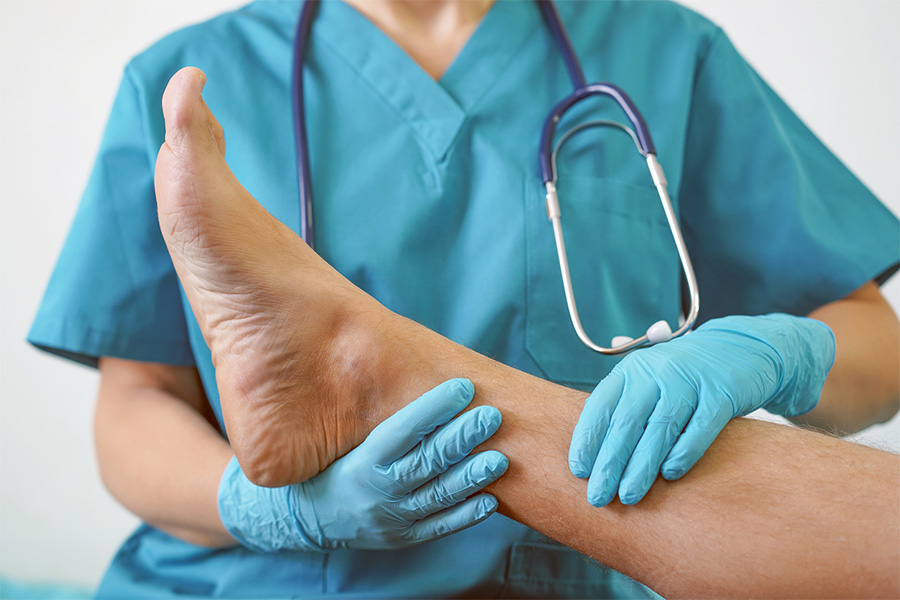Foot infections can be painful and make it difficult for you to walk and carry out normal day-to-day activities. An infection can occur in many forms, such as a fungal infection like athlete’s foot or a bacterial infection from a wound or injury.
Some medical conditions, such as diabetes, can increase your risk of foot infections. If you have a foot infection, particularly an infected wound, it should be examined by a podiatrist in order to receive the best treatment and to prevent it from becoming a more serious problem.
Common infections that affect the feet are:
Athletes Foot
Athletes foot is a common and contagious fungal infection. It often develops after direct exposure to fungus, typically in a moist environment like a locker room, public shower, or swimming pool or from skin-to-skin contact with an infected person. Athletes foot can cause mild to severe symptoms, which include a scaly rash that can burn, sting, and itch. The rash may lead to blisters, bumps, or dry, cracked, and peeling skin. It usually appears between the toes or on the soles of the feet and may cause an unpleasant odor. The condition can repeatedly come back and also spread to the toenails and cause a fungal nail infection.
Athletes foot can usually be treated with over-the-counter medications and specifically formulated powders, creams, sprays, and lotions. Stronger medication may be prescribed by your podiatrist if the condition is severe or if other treatments fail to work.
Toenail Fungal Infections
A toenail fungus infection can be unsightly and difficult to treat. It develops when fungi enter the nail through a wound or small opening. It grows best in warm, moist environments, such as damp socks or shoes. The first signs of toenail fungus are white or yellow spots under the tip of the nail. As it progresses, the toenail will thicken and become discolored (brown, yellow, or white) and may become brittle and ragged. It may cause pain and an unpleasant odor.
It is recommended you see your podiatrist if you have a toenail fungus infection because toenail fungus is difficult to treat, and oftentimes, over-the-counter products do not work well. Your podiatrist will trim your toenail and treat it with the application of medicated nail polish or oral antifungal medication. It can take 4 months or more for the toenail fungal infection to heal and a new toenail to grow.
Plantar Warts
Plantar warts are small growths that often develop on the sole of the foot. They are caused by a viral infection – human papillomavirus (HPV) – in the top layer of the skin and are highly contagious, either by direct contact with a wart or indirectly, such as from floors in communal areas (locker rooms, public showers, etc.). Warts typically grow on the outer layer of skin, but plantar warts can grow into the deeper layers, which can be very painful. They appear brown, gray, or yellow and may have tiny spots and feel spongy or rough to the touch. The warts may bleed if knocked or scraped and may be especially uncomfortable when you stand or walk.
Plantar warts may eventually go away on their own without treatment, but if they are painful, your podiatrist can remove them with liquid nitrogen or cryotherapy, which freezes and removes tissue. Other treatments include laser therapy and surgery.
Diabetic Foot Infections and Ulcerations
People with diabetes are at increased risk for developing infections and ulcers on feet because of complications like diabetic neuropathy (nerve damage) and peripheral artery disease (poor circulation). Nerve damage can cause a loss of sensation in the feet, meaning foot problems may get overlooked. Poor circulation slows down the healing process, increasing the chance of infection and complications.
Foot Infection Treatment in Southwest Ohio
At Cincinnati Foot & Ankle Care, we offer comprehensive foot and ankle care. Our experienced podiatrists specialize in the treatment of infections and ulcers of the foot and ankle, and we offer complete diabetic foot care.
If you would like to schedule a consultation, or learn more about the services we provide, call us at the location nearest to you or request an appointment online.





